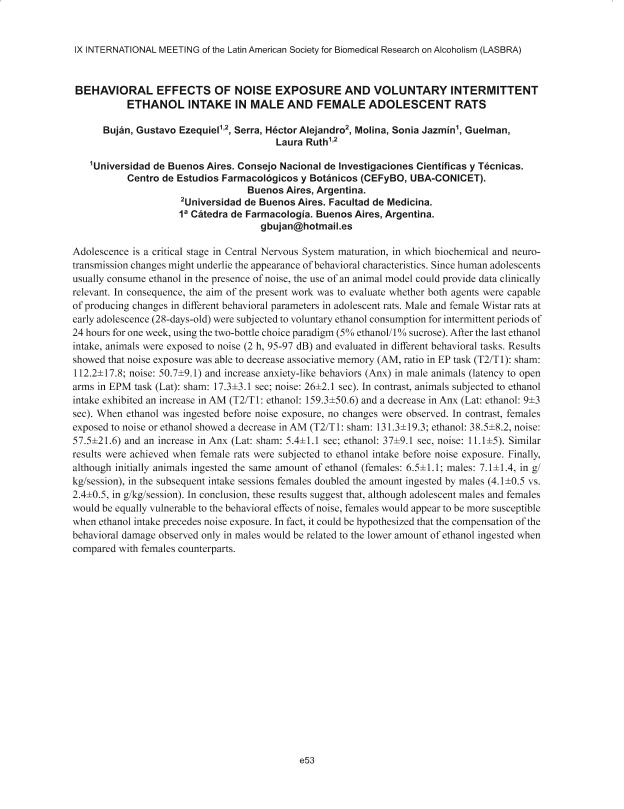Evento
Behavioral effects of noise exposure and voluntary intermittent ethanol intake in male and female adolescent rats
Tipo del evento:
Reunión
Nombre del evento:
IX Inintenational Meeting of the Latin American Society for Biomedical Research on Alcoholism
Fecha del evento:
07/11/2019
Institución Organizadora:
Latin American Society for Biomedical Research on Alcoholism;
Título de la revista:
Journal of Fetal Alcohol Spectrum Risk and Prevention
Editorial:
Latin American Society for Biomedical Research on Alcoholism
Idioma:
Inglés
Clasificación temática:
Resumen
Adolescence is a critical stage in Central Nervous System maturation, in which biochemical and neurotransmission changes might underlie the appearance of behavioral characteristics. Since human adolescents usually consume ethanol in the presence of noise, the use of an animal model could provide data clinically relevant. In consequence, the aim of the present work was to evaluate whether both agents were capable of producing changes in different behavioral parameters in adolescent rats.Male and female Wistar rats at early adolescence (28-days-old) were subjected to voluntary ethanol consumption for intermittent periods of 24 hours for one week, using the two-bottle choice paradigm (5% ethanol/1% sucrose). After the last ethanol intake, animals were exposed to noise (2 h, 95-97 dB) and evaluated in different behavioral tasks.Results showed that noise exposure was able to decrease associative memory (AM, ratio in EP task (T2/T1): sham: 112.217.8; noise: 50.79.1) and increase anxiety-like behaviors (Anx) in male animals (latency to open arms in EPM task (Lat): sham: 17.33.1 sec; noise: 262.1 sec). In contrast, animals subjected to ethanol intake exhibited an increase in AM (T2/T1: ethanol: 159.350.6) and a decrease in Anx (Lat: ethanol: 93 sec). When ethanol was ingested before noise exposure, no changes were observed. In contrast, females exposed to noise or ethanol showed a decrease in AM (T2/T1: sham: 131.319.3; ethanol: 38.58.2, noise: 57.521.6) and an increase in Anx (Lat: sham: 5.41.1 sec; ethanol: 379.1 sec, noise: 11.15). Similar results were achieved when female rats were subjected to ethanol intake before noise exposure. Finally, although initially animals ingested the same amount of ethanol (females: 6.51.1; males: 7.11.4, in g/kg/session), in the subsequent intake sessions females doubled the amount ingested by males (4.10.5 vs. 2.40.5, in g/kg/session).In conclusion, these results suggest that, although adolescent males and females would be equally vulnerable to the behavioral effects of noise, females would appear to be more susceptible when ethanol intake precedes noise exposure. In fact, it could be hypothesized that the compensation of the behavioral damage observed only in males would be related to the lower amount of ethanol ingested when compared with females counterparts.
Palabras clave:
Ethanol intake
,
Noise exposure
,
behavioral effects
Archivos asociados
Licencia
Identificadores
Colecciones
Eventos(CEFYBO)
Eventos de CENTRO DE ESTUDIOS FARMACOLOGICOS Y BOTANICOS
Eventos de CENTRO DE ESTUDIOS FARMACOLOGICOS Y BOTANICOS
Citación
Behavioral effects of noise exposure and voluntary intermittent ethanol intake in male and female adolescent rats; IX Inintenational Meeting of the Latin American Society for Biomedical Research on Alcoholism; Cordoba; Argentina; 2019; 1-1
Compartir




